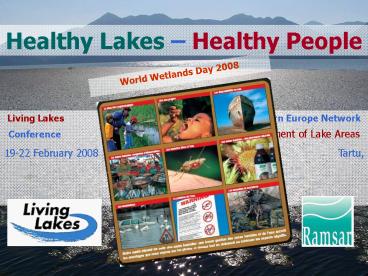COP8 Master PPT Final version - PowerPoint PPT Presentation
1 / 12
Title:
COP8 Master PPT Final version
Description:
Ramsar focuses on Aquatic, Subterranean and Coastal marine ecosystems ... lake use management (fisheries, sports, transport, sanctuaries without disturbance) ... – PowerPoint PPT presentation
Number of Views:46
Avg rating:3.0/5.0
Title: COP8 Master PPT Final version
1
Healthy Lakes Healthy People
World Wetlands Day 2008
Living Lakes
Eastern Europe Network
Conference Sustainable
Development of Lake Areas
19-22 February 2008
Tartu, Lakes Võrtsjärv Peipsi, Estonia
Tobias Salathé, Ramsar Convention
Secretariat
2
the 3 pillars of the Ramsar Convention
- Wise Use (sustainable use) of all wetlands
through national land-use planning, appropriate
policies and legislation, management actions and
public eduction - designation of suitable wetlands for the List of
Wetlands of International Importance
(Ramsar Sites) and ensuring their effective
management to maintain their ecological
character, provide training, undertake necessary
research and monitoring - International Cooperation concerning
transboundary wetlands, shared wetland systems
(and water catchments), shared species, and
development projects that may affect wetland
ecosystems
3
the global water cycle maintains and links all
environmental components Ramsar focuses on
Aquatic, Subterranean and Coastal marine
ecosystems
4
lakes are wetlands
the Ramsar classification of wetland types
includes marine/coastal wetlands coastal
brackish/saline and freshwater lagoons (J,
K) inland wetlands permanent and
seasonal/intermittant freshwater,
saline/brackish/alkaline lakes and flats (gt 8 ha)
(O, P, Q, R) human-made wetlands water storage
areas (reservoirs/barrages/dams/impoundments
generally over 8 ha) (6)
5
living lakes in Eastern Europe
are particularly numerous in the basins
of Baltic, White and Barents seas Black and
Mediterranean seas Anatolian plateau Caspian sea
and Persian gulf Eastern Europe is arguably
among the Worlds regions most rich
in lakes
6
lake ecosystem services
provisioning
drinking water supply,
fisheries, energy reservoir regulating
water retention, climate regulation, water
purification, flood retention cultural
leisure, recreation, education, tourism,
sport supporting
nutrient cycling,
landscape, well-being
7
the need to pay for lake ecosystem services
a step-wise approach identify services provided
by our lake assess the costs to maintain
them compare with the costs for technical
solutions (for some services no
technical solutions may be possible) value the
lake ecosystem services establish payment schemes
(public, private, public-private)
8
lakes for sustainable development
need for a catchment basin approach water
quantity management (inflows, outflow, level)
water quality management (pollution,
eutrophication, agriculture, urban,
industrial) changing climate lake water
stratification and mixing the waterbody and its
surroundings lake use management (fisheries,
sports, transport, sanctuaries without
disturbance) lake shore management
9
healthy lake ecosystems make human societies
healthy
lake ecosystems have limits, often poor
sanitation, industrial waste, excessive sewage
inflow, and agricultural runoff surpass the
cleansing capacity of lakes the costs of poor
management can be high, thus management
has to support both the health of lake ecosystems
and the health of humans closer cooperation
between lake ecologists, water managers and
health researchers is needed
10
designate lakes for the Ramsar List
Ramsar Site criterias for lakes representative,
rare or unique examples important for
biodiversity (endemics) threatened animals and
plants hosting regularly 20000 or more
waterbirds hosting gt1 of any biogeographical
animal population important feeding, fraying,
nursery, growing area for fish
11
Ramsar Handbooks
17 volumes (english, français,
español) available on CD
or directly via Internet
1 wise use of wetlands 2-3 policies
and legislation 4-5 CEPA, participatory
skills 6-9 water-related issues
riverbasins, groundwater, water allocation
10 spatial planning (coastal management) 11-13 i
nventory, assessment and monitoring 14-16 Ramsar
site designation and management
17 international cooperation
www.ramsar.org/lib/lib_handbooks2006_e.htm
12
working together for healthy living lakes
- firmly establish the regional lake network -
expand it to cover all 19 countries of Eastern
Europe - bring lake experience into the global
Convention 6th European Ramsar Meeting
Stockholm 3-7 May 2008 gt special session on
living lakes lt































